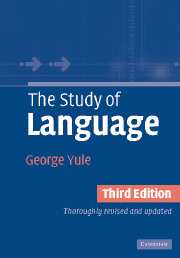Book contents
- Frontmatter
- Contents
- Preface
- The origins of language
- Animals and human language
- The development of writing
- The sounds of language
- The sound patterns of language
- Words and word-formation processes
- Morphology
- Phrases and sentences : grammar
- Syntax
- Semantics
- Pragmatics
- Discourse analysis
- Language and the brain
- First language acquisition
- Second language acquisition/learning
- Gestures and sign languages
- Language history and change
- Language and regional variation
- Language and social variation
- Language and culture
- Appendix: Suggested answers to study questions
- Glossary
- References
- Index
Morphology
- Frontmatter
- Contents
- Preface
- The origins of language
- Animals and human language
- The development of writing
- The sounds of language
- The sound patterns of language
- Words and word-formation processes
- Morphology
- Phrases and sentences : grammar
- Syntax
- Semantics
- Pragmatics
- Discourse analysis
- Language and the brain
- First language acquisition
- Second language acquisition/learning
- Gestures and sign languages
- Language history and change
- Language and regional variation
- Language and social variation
- Language and culture
- Appendix: Suggested answers to study questions
- Glossary
- References
- Index
Summary
BAMBIFICATION: The mental conversion of flesh and blood living creatures into cartoon characters possessing bourgeois Judeo-Christian attitudes and morals.
Coupland (1991)Throughout the preceding chapter, we approached the description of processes involved in word formation as if the unit called the ‘word’ was always a regular and easily identifiable form, even when it is a form such as bambification that we may never have seen before. This doesn't seem unreasonable when we look at a text of written English, since the ‘words’ in the text are, quite obviously, those sets of things marked in black with the bigger spaces separating them. Unfortunately, there are a number of problems with using this observation as the basis of an attempt to describe language in general, and individual linguistic forms in particular.
Morphology
In many languages, what appear to be single forms actually turn out to contain a large number of ‘word-like’ elements. For example, in Swahili (spoken throughout East Africa), the form nitakupenda conveys what, in English, would have to be represented as something like I will love you. Now, is the Swahili form a single word? If it is a ‘word’, then it seems to consist of a number of elements which, in English, turn up as separate ‘words’.
- Type
- Chapter
- Information
- The Study of Language , pp. 62 - 72Publisher: Cambridge University PressPrint publication year: 2005



